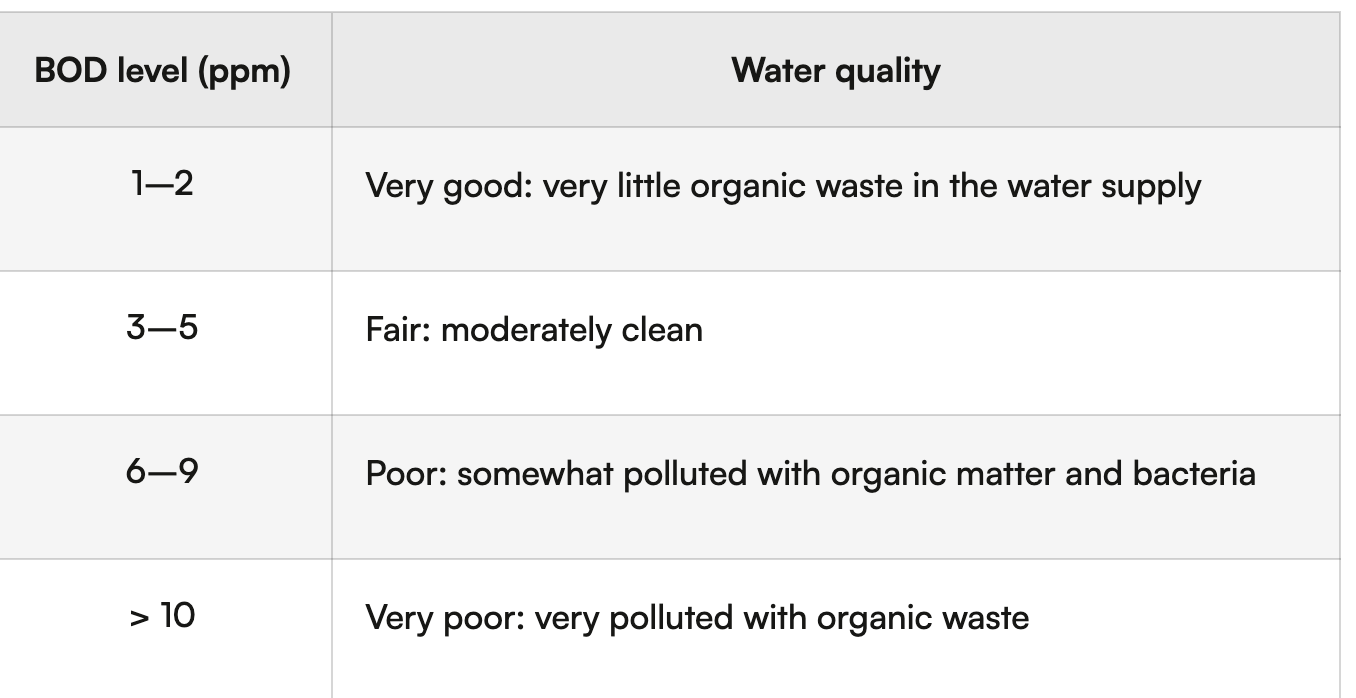Water quality - abiotic factors
1/16
There's no tags or description
Looks like no tags are added yet.
Name | Mastery | Learn | Test | Matching | Spaced |
|---|
No study sessions yet.
17 Terms
What is water polluted by? (4)
waste products (organic pollutants)
bacteria
chemical pollution from factories
solid waste
Dissolved Oxygen (DO)
A measure of how much oxygen is dissolved in the water - the amount of oxygen available to living aquatic organisms.
DO Meaning
Oxygen is essential for respiration, so when insufficient dissolved oxygen is present then aquatic organisms may suffer from hypoxia or anoxia —> high = good
hypoxia
A condition in which the body or a region of the body is deprived of adequate oxygen supply at the tissue level.
anoxia
Absence or lack of oxygen.
biochemical oxygen demand (BOD)
A measure of the amount of dissolved oxygen required by microorganisms to decompose organic material in water.
BOD meaning
The higher that value is, the more oxygen has been used by microorganisms in the water to decompose organic matter. So a high BOD indicates a high level of organic pollution in the water. Table 1 outlines what different BOD levels indicate about water quality.

How to measure BOD
To measure the BOD, the initial dissolved oxygen (DO) level in a water sample is recorded with an oxygen probe. Then the sample is placed in a dark environment for five days at a controlled temperature (for example, 20°C). After five days, the DO level is recorded a second time. BOD is determined by the difference between the first and second DO levels.
Temperature (2)
Warmer water with lower DO levels can cause hypoxia and large-scale death of aquatic organisms as it holds less dissolved oxygen
Warmer temperatures increase the rate of metabolic processes, while colder temperatures slow them down. When the rate of metabolic processes that support life is higher, so is respiration rate and the amount of dissolved oxygen required.
optimal : 20 to 25
pH
indicates the acidity or alkalinity of water and is measured with pH probes. Different aquatic species thrive in specific pH ranges.
alkaline —> nutrient avalibility, cause deposits to
Consequences of extreme pH
Alkaline: Alkaline water can lead to more frequent and larger volumes of urine, which can strain the kidney
Alkaline water may interfere with the normal function of digestive enzymes, affecting the ability to break down food and absorb nutrients.
Acidic: ocean acidification
Turbidity
ack of water clarity, caused by the presence of suspended particles and organic matter.
turbidity meaning
Excessive turbidity can limit light penetration and therefore hinder photosynthesis and disrupt the flow of energy and matter through food webs
Turbidity can be measured with Secchi disks. A Secchi disk is lowered into the water until it is not visible. The depth at which the disk disappears indicates the level of turbidity.
Concentrations of nutrients (nitrates and phospates)
EUTROPHICATION
measured using test kits
heavy metals (lead, mercury, cadmium)
rom industrial discharge, mining and stormwater run-off are common types of dangerous water pollution. Their presence is measured using advanced techniques like
atomic absorption spectroscopy
—> harmful for children, growth and development
heavy metals (arsenic)
poisonous
found in rice from groundwater
total suspended solid matter
a measure of the amount of particles suspended in water. They come from run-off of silt and organic matter. These particles reduce water clarity and harm aquatic organisms by reducing light penetration and thus photosynthesis.